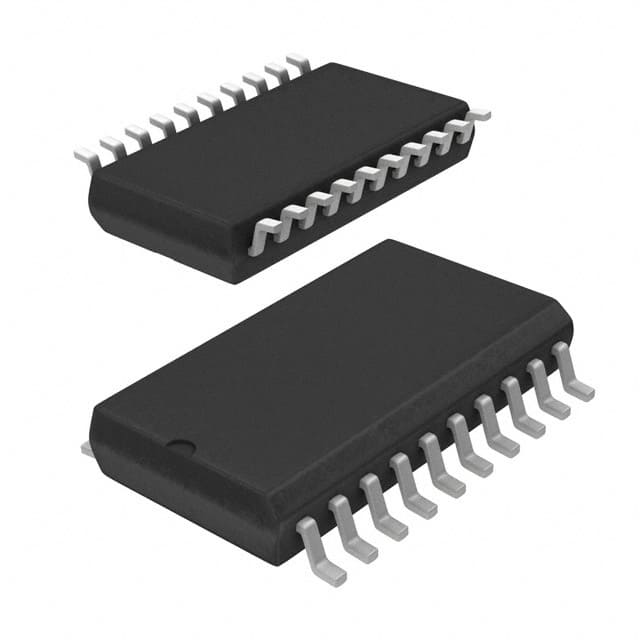Lihat spesifikasi untuk detail produk.

SN74AS245DW
Product Overview
Category
SN74AS245DW belongs to the category of integrated circuits (ICs).
Use
This IC is commonly used for level shifting and bus transceiver applications.
Characteristics
- High-speed operation
- Wide voltage range
- Bidirectional data transfer capability
- 3-state outputs
- TTL-compatible inputs
Package
SN74AS245DW is available in a standard 20-pin SOIC (Small Outline Integrated Circuit) package.
Essence
The essence of SN74AS245DW lies in its ability to facilitate the bidirectional transfer of data between two buses with different voltage levels.
Packaging/Quantity
SN74AS245DW is typically packaged in reels or tubes, with quantities varying depending on the supplier.
Specifications
- Supply Voltage: 4.5V to 5.5V
- Input Voltage Range: 0V to VCC
- Output Voltage Range: 0V to VCC
- Operating Temperature Range: -40°C to +85°C
- Maximum Propagation Delay: 12ns
- Maximum Operating Frequency: 24MHz
Detailed Pin Configuration
- DIR (Direction Control)
- GND (Ground)
- B1 (Bus B Data Input/Output)
- B2 (Bus B Data Input/Output)
- B3 (Bus B Data Input/Output)
- B4 (Bus B Data Input/Output)
- B5 (Bus B Data Input/Output)
- B6 (Bus B Data Input/Output)
- B7 (Bus B Data Input/Output)
- B8 (Bus B Data Input/Output)
- VCC (Supply Voltage)
- A1 (Bus A Data Input/Output)
- A2 (Bus A Data Input/Output)
- A3 (Bus A Data Input/Output)
- A4 (Bus A Data Input/Output)
- A5 (Bus A Data Input/Output)
- A6 (Bus A Data Input/Output)
- A7 (Bus A Data Input/Output)
- A8 (Bus A Data Input/Output)
- OE (Output Enable)
Functional Features
- Bidirectional data transfer between two buses
- Automatic direction control based on DIR input
- 3-state outputs for bus isolation
- TTL-compatible inputs for easy interfacing with other ICs
Advantages and Disadvantages
Advantages
- High-speed operation allows for efficient data transfer
- Wide voltage range enables compatibility with various systems
- Bidirectional capability simplifies circuit design
- 3-state outputs provide flexibility in bus management
- TTL-compatible inputs ensure seamless integration with other components
Disadvantages
- Limited maximum operating frequency compared to some newer ICs
- May not be suitable for applications requiring extremely high-speed data transfer
Working Principles
SN74AS245DW operates by receiving data from one bus (A) and transmitting it to another bus (B), or vice versa, depending on the direction control signal (DIR). The bidirectional data transfer is facilitated through a combination of internal logic gates and transistors. When the output enable signal (OE) is active, the outputs are enabled, allowing data to flow freely between the two buses. In the disabled state, the outputs are in a high-impedance state, effectively isolating the buses.
Detailed Application Field Plans
SN74AS245DW finds application in various fields where level shifting and bus transceiver functions are required. Some common application areas include:
- Microcontroller interfacing
- Communication systems
- Industrial automation
- Automotive electronics
- Data acquisition systems
Detailed and Complete Alternative Models
- SN74LS245: Similar functionality with lower power consumption
- SN74HC245: Higher speed operation with lower voltage levels
- SN74LVC245: Lower voltage operation with improved noise immunity
- SN74LVCH245A: Bi-directional level shifting with 5V tolerant inputs
These alternative models offer similar functionality to SN74AS245DW but may have different characteristics or specifications that make them suitable for specific applications.
In conclusion, SN74AS245DW is a versatile IC used for level shifting and bus transceiver applications. Its bidirectional data transfer capability, high-speed operation, and wide voltage range make it suitable for various fields such as microcontroller interfacing, communication systems, and industrial automation. While it has certain limitations in terms of maximum operating frequency, there are alternative models available to meet specific requirements.
Sebutkan 10 pertanyaan dan jawaban umum terkait penerapan SN74AS245DW dalam solusi teknis
Sure! Here are 10 common questions and answers related to the application of SN74AS245DW:
Q: What is SN74AS245DW? A: SN74AS245DW is a bidirectional octal bus transceiver that can be used to enable bidirectional communication between two buses.
Q: What is the voltage range supported by SN74AS245DW? A: SN74AS245DW supports a voltage range of 4.5V to 5.5V.
Q: How many channels does SN74AS245DW have? A: SN74AS245DW has 8 channels, allowing bidirectional data transfer on each channel.
Q: What is the maximum data transfer rate supported by SN74AS245DW? A: SN74AS245DW supports a maximum data transfer rate of 24 MHz.
Q: Can SN74AS245DW be used for level shifting between different voltage domains? A: Yes, SN74AS245DW can be used for level shifting as it supports bidirectional voltage translation.
Q: Does SN74AS245DW have any built-in protection features? A: No, SN74AS245DW does not have built-in protection features. External protection components may be required depending on the application.
Q: Can SN74AS245DW be used in both parallel and serial communication systems? A: Yes, SN74AS245DW can be used in both parallel and serial communication systems, depending on the configuration and requirements.
Q: What is the power supply requirement for SN74AS245DW? A: SN74AS245DW requires a single power supply voltage of 4.5V to 5.5V.
Q: Can SN74AS245DW be used in high-speed data transmission applications? A: Yes, SN74AS245DW can be used in high-speed data transmission applications as it supports a maximum data transfer rate of 24 MHz.
Q: Are there any specific layout considerations for using SN74AS245DW? A: Yes, it is recommended to follow the layout guidelines provided in the datasheet to ensure proper signal integrity and minimize noise coupling.
Please note that these answers are general and may vary depending on the specific application and requirements. It is always advisable to refer to the datasheet and consult with technical experts for accurate information.

